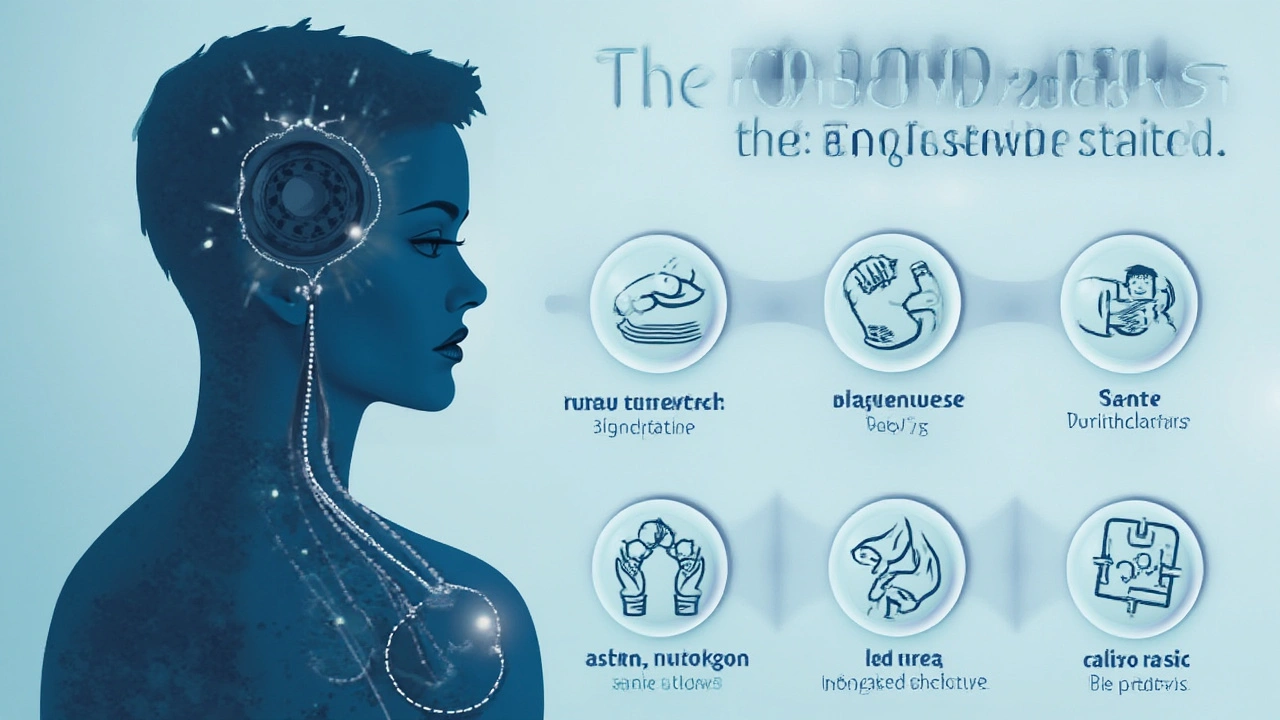If you mention depression treatment, most people jump to SSRIs like Zoloft or therapy sessions in small rooms filled with cheap tissues. Hardly anyone brings up Emsam. But this unique antidepressant patch has quietly changed the game for some people, especially those who can’t tolerate or don’t respond to the usual pills. It’s not just an alternative—it’s another route entirely.
What is Emsam and How Does It Work?
Emsam isn’t your regular antidepressant. Instead of popping a pill every morning, you slap on a little patch that sticks to your skin, sending the medicine right into your bloodstream. The patch contains selegiline, which is part of an older family of antidepressants called monoamine oxidase inhibitors, or MAOIs. They’ve been around since the 1950s, and for a while, they were everywhere. Then newer medications took over, mainly because the early MAOIs came with a load of food restrictions and safety worries.
Emsam flips the script by delivering selegiline directly through your skin, skipping your gut. That means you dodge many classic MAOI food problems, like having to say no to cheese platters or red wine. Most users at lower patch strengths (6mg/24h) don’t need to follow the strict “tyramine diet” that the older MAOIs require—unless they’re on the higher doses. That alone makes it a life-changer for some folks.
This patch works by blocking the enzyme monoamine oxidase in the brain. That enzyme usually breaks down the major mood-regulating neurotransmitters, such as serotonin, dopamine, and norepinephrine. When you block it, those feel-good chemicals stick around longer, which can help lift your mood and sometimes sharpen your focus. Scientists think that’s why Emsam helps with depression, especially the kind that doesn’t seem to budge with the usual treatments.
One thing that sets Emsam apart is the way your body takes it in. By absorbing through the skin, you skip the digestive system and first-pass metabolism in the liver. That could mean fewer interactions with food and, for some, fewer typical side effects. Still, it’s not side-effect-free, and it’s not for everyone. The unique delivery system does make it interesting, though—especially if you dread swallowing more pills.
Take a look at how Emsam compares with traditional MAOIs and more common antidepressants:
| Feature | Emsam (Selegiline patch) | Traditional MAOI pills | SSRIs/SNRIs |
|---|---|---|---|
| Delivery Method | Transdermal patch | Oral pill | Oral pill/capsule |
| Food Restrictions | Low at 6mg/24h, required at higher | Strict | None |
| Drug Interactions | Moderate/High | High | Low/Moderate |
| Effect On Treatment-Resistant Depression | Good evidence | Strong evidence | Mixed |
No antidepressant is perfect. But for some, especially those who haven’t found relief elsewhere, Emsam provides a much-needed alternative route.
Who Might Consider Emsam?
Most GPs don’t jump straight to Emsam when you first walk in with symptoms. It’s not usually the first choice, but that’s changing as awareness grows. Here’s who might want to talk to their doctor about it:
- Treatment-resistant depression: If you’ve been through rounds of SSRIs and SNRIs and still feel stuck, Emsam can be a real shot at relief.
- Poor tolerance to pills: Some people just can’t stomach oral antidepressants, either literally or because of allergies or side effects. The patch sidesteps the gut completely.
- People who have trouble remembering pills: Slap on Emsam every day and you don’t have to remember a midday dose.
- Anyone dealing with major depressive disorder who isn’t getting results with regular meds.
It’s a specialist script in Australia, and many psychiatrists are still learning best practices with it. People living with HIV who take multiple drugs, or those with complex health conditions, are usually monitored closely due to possible interactions. Young people under 18 aren’t supposed to use Emsam, and it isn’t approved for bipolar disorder or for anxiety disorders on its own.
If you plan to get pregnant or are breastfeeding, let your doctor know. There isn’t enough data to say whether Emsam is safe. Same goes for folks with a history of certain heart conditions or uncontrolled high blood pressure—it might not be the best pick.
Sometimes, patients who struggle with daytime drowsiness from other antidepressants try Emsam and notice a boost in energy. Some people handling chronic fatigue along with depression report better motivation and mental clarity, though not everyone gets the same result. And don’t expect to slap on the patch and wake up a new person. For most, it takes a few weeks to feel a clear difference.

How To Use the Emsam Patch Safely
The start of Emsam can look a bit like launching a new phone—there’s a learning curve but it gets easier. The patch comes in three strengths: 6mg, 9mg, and 12mg per 24 hours. Most people start on the lowest dose unless their doctor recommends otherwise.
Tips for using Emsam without headaches:
- Always apply the patch to clean, dry, hairless skin—outside of cuts, scars, or rashes. Switch up the spot every day.
- Popular places: outer arms, upper chest, upper back, or upper thighs. Avoid waistbands or spots that rub on clothes. If a patch falls off, put a new one on and reset the clock for your daily routine.
- Hold the patch down for 30 seconds to make sure it sticks, especially if you just had a shower or it’s humid.
- Avoid using creams or lotions under the patch—it won’t stick as well, and you want steady absorption.
- Don’t double up if you forget a dose. Just start fresh when you remember.
- Once a patch is used, fold it sticky-sides together and toss in the bin. Keep out of reach of kids and pets since used patches still contain medicine.
Important: Even at the lowest dose, check in with your doctor or pharmacist before mixing Emsam with any other medication or supplement—not all antidepressants play nice with it.
If you need surgery or dental work, let your provider know you’re on an MAOI, because some anaesthetics and painkillers can cause serious reactions. The same warning goes for recreational drugs or even over-the-counter cold tablets. Sudafed, decongestants, certain migraine meds (like sumatriptan), and stimulants can cause blood pressure spikes—the “cheese reaction” everyone warns about.
The good news? If you’re at 6mg, the risk of most food-related reactions is fairly low, according to research published in the Journal of Clinical Psychiatry. But once you go up to 9mg or 12mg, you’ll need to check that tyramine list and steer clear of anything aged, fermented, or cured, especially hard cheeses, soy sauce, and some draft beers. Most people find the diet manageable with some planning.
Real Experiences: What Do People Say About Emsam?
You probably won’t find Emsam commercials on Aussie TV or see it on billboards. But if you scroll through depression forums or chat with mental health support groups, you’ll bump into some honest stories.
One Sydney user, Mark (34), tried Emsam after four years of cycling through SSRIs and SNRIs. His anxiety-heavy depression never shifted until he stuck with the patch for two months. “I had way more clarity,” he recalls. “The side effects were less than the pills—no dry mouth, no sexual problems. But if I skipped a day, I’d feel off for sure.”
Katie, a teacher from Melbourne, used Emsam after her doctor ran out of ideas. The first couple of weeks brought some agitation and trouble sleeping, but she hung in. “After a month, it was like my mood was brighter, but also—I had energy again.” She mentions that sticking the patch on her thigh worked better than her arm, since it stayed put all day even with lots of movement. One downside she noted: the cost. “It was pricier than my old generic antidepressant, but worth it because my quality of life is better.”
People also share that the patch can irritate sensitive skin. Redness, itching, and occasional blistering can pop up, especially if you don’t rotate where you stick it. Some switch to a different body area each day and use gentle soap to prep their skin. For those with very sensitive skin, a barrier spray or wipe helps cut down on itch.
And then there are those who don’t get much out of it. “I tried it for three months—nothing changed,” says a user on a popular Australian mental health forum. “Just goes to show, what works well for some doesn’t for others.” That’s a frustrating reality with all mental health care, but it’s helpful to see honest accounts before you try something new.
At least one benefit stands out: nearly everyone who gets a strong effect from Emsam says they appreciate not worrying about weight gain, a common complaint with traditional pills. According to a 2023 clinical trial out of the University of Queensland, less than 9% of Emsam users saw any significant weight increase over six months—compared to over 25% on SSRIs.

Side Effects, Interactions, and What to Expect
Even though Emsam skips your gut, it doesn’t skip over your side-effect radar completely. Most people will have an adjustment period. Insomnia comes up often, as does mild nausea for some folks in the first few days. Irritation at the patch site is probably the top complaint—red skin or a bit of itchiness isn't uncommon. Sometimes switching up the daily location and using gentle cleansers helps keep that in check.
Dizziness and headaches pop up in around 10-15% of people, according to a study published in the American Journal of Psychiatry in 2022. Rarely, people get more serious side effects: sudden spikes in blood pressure, trouble breathing, hallucinations, or severe headaches. If that happens, get medical help fast. The true scary risk is serotonin syndrome—a dangerous chemical imbalance that can happen if you take Emsam with many other antidepressants, painkillers, or the wrong meds. Watch for confusion, fever, sweating, twitching, or rapid heart rate. If in doubt, call your doctor right away.
Don’t forget the strict wash-out period. If you switch from an SSRI or SNRI to Emsam (or back), your doctor will probably want you drug-free for at least 2 weeks before and after. That’s because too much serotonin stacking up can be dangerous. There’s no cutting corners—timing matters.
How does Emsam stack up for side effects compared to other treatments? Here’s a quick overview:
| Side Effect | Emsam Patch Users (%) | SSRI Users (%) |
|---|---|---|
| Insomnia | 22 | 17 |
| Sexual Dysfunction | 8 | 34 |
| Skin Reactions | 26 | 1 |
| Significant Weight Gain | 9 | 25 |
The patch means you basically have medicine on you all day. If you head to the beach or the gym in Sydney’s humid summer, check that it’s still sticking. Sweat can loosen it, so a quick press with your hand can help. For swimmers and athletes, some try waterproof medical tape as extra security.
Alcohol is a bit of a grey area. At the lowest dose, no special warnings, but with higher doses, combine with caution. As always, moderation is key, and if you’re not sure, ask your doc.
Compared to older MAOIs, travel and daily living get easier. You keep your usual diet at low doses, and you don’t need special ID cards unless you go up in dose—or if you prefer peace of mind. Still, it’s worth letting close friends or a partner know you’re on an MAOI patch. If you suddenly feel very ill, they can help you get fast medical help and inform doctors about what meds you’re using.
Australian health insurance sometimes covers Emsam, but it costs more than the usual oral antidepressants. Ask your psychiatrist or GP for a prescription and look into PBS or private insurance rebates, since prices can surprise people new to the patch.
Emsam may not be as famous as the standard pills for depression, but it carves out a unique space—especially for those who’ve hit a wall with other meds. If you’re considering the patch, talk to your doctor about the pros, the cons, and how it might fit into your life. For quite a few Sydney locals, this little patch has become a big part of the journey to feeling better.








Christy Tomerlin
July 6, 2025 AT 13:26Wow, another person acting like Emsam is some miracle cure? In America we’ve got real medicine-pills you can swallow, not some sticky band-aid for grown-ups who can’t remember to take their meds. And don’t get me started on the cost. This patch costs more than my rent in Texas. You want real depression treatment? Go work out. Eat protein. Stop being so weak.
Susan Karabin
July 6, 2025 AT 18:35the patch is just another way for your body to heal itself without fighting your digestion
some people’s stomachs are like angry volcanoes when it comes to pills
but skin? skin just listens
no drama no panic no weird food rules at 6mg
it’s like your body finally got a quiet roommate instead of a screaming roommate
and yeah it takes time
but so does healing
not everything needs to be fast to be right
Lorena Cabal Lopez
July 6, 2025 AT 20:51Seems like a lot of effort for something that might not even work. I tried patches for pain before. They always fell off. And why pay more for less control? Just take the pill. Simple.
Stuart Palley
July 7, 2025 AT 01:53THIS IS THE MOST IMPORTANT THING NO ONE IS TALKING ABOUT
THE FACT THAT EMSAM DOESN’T KILL YOUR SEX DRIVE IS A REVOLUTION
SSRIs turned me into a zombie with no libido and zero motivation to even look at a human being
then I tried the patch
suddenly I was kissing my partner again
and yes the skin irritation sucked
but I’d rather have a red spot on my thigh than a dead soul
Glenda Walsh
July 7, 2025 AT 03:01Did you know that Emsam can interact with NyQuil? And also with dextromethorphan? And also with St. John’s Wort? And also with over-the-counter cold medicine? And also with certain cheeses? And also with soy sauce? And also with red wine? And also with… oh my gosh, I’m so worried for you. Please, please, please talk to your pharmacist. And maybe your priest. And your yoga instructor. And your dog. Just make sure you’re not going to die from a patch.
Tanuja Santhanakrishnan
July 7, 2025 AT 07:20As someone who’s been on both sides of this-SSRIs that made me feel like a foggy ghost and now Emsam that lets me breathe again-I can say this patch is a quiet superhero
Yes, the skin gets itchy sometimes
Yes, it costs more than your weekly coffee habit
But for the first time in years, I woke up without dread clinging to my chest
And no, I don’t need to avoid my favorite masala chai
At 6mg, the world didn’t turn into a food police state
It’s not magic
But it’s medicine that respects your body’s rhythm
And if you’ve tried everything else and still feel stuck
Give this a real shot
Not as a last resort
But as a different kind of hope